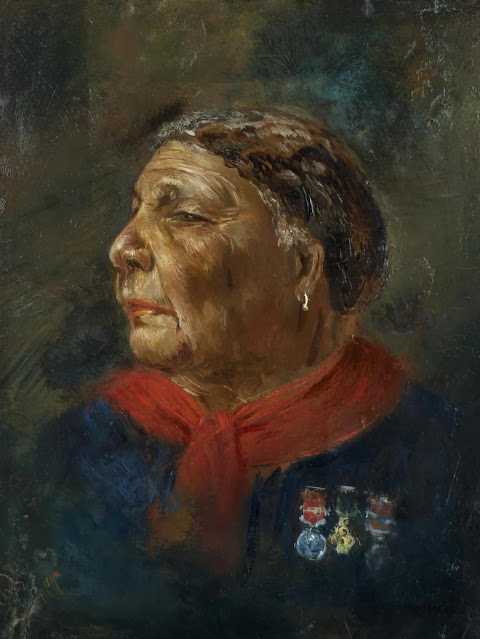I quite often write quotes or little notes for the blog into my phone. I’ve often used them. But I have to remember to type in where I heard them or the credit will never be given. I thought I was definitely watching something on TV when someone said, “It’s very important to look great if you want to make a point.” It might’ve been drag queens on YouTube but whatever, I didn’t write down who said it. It’s going to annoy me because it’s true. You at least might feel more confident if you looked your best & knew it. In any case, portraits don’t always have to be making a point. Sometimes they’re just a record of a person who was here.
Frans Hals (1580/5-1666), Verdonck, c. 1627
Anyone that likes a portrait surely loves a Frans Hals. It’s the honesty & good humour in most of his subjects. You can tell he likes humanity in all its flawed glory. He finds beauty, fun & interest in the ordinary, wrinkly & downtrodden. His paintings are wonderful & lively, often humorous. & no that isn’t a humerus, it’s a jawbone.
(I should be sorry but I'm not).
John Singer Sargent (1856-1927), Lady Agnew of Lochnaw, 1892
A portrait ubiquitous in the Scottish art world because we’re proud of our gallery acquisitions (in this case the Scottish National Gallery in Edinburgh), Lady Agnew’s is a weel-kent face. We can see the likeness JSS achieves from the photo of Gertrude Vernon as she was at the time, but that’s Sargent all over. You get the highest quality. As an interesting aside, it remains in its original frame, which it is thought was very “expensive” at the time, costing £20.
Stephen Buckley (b.1944), Head of a Young Girl, 1975
It’s here in Aberdeen Art Gallery & I will admit, it’s a challenge. You can just about see it if you squint. But yeah, totally, it’s a challenge.
Giuseppe Arcimboldo (1526/7-1593), The Librarian, 1566
Oh look! He’s made a LIBRARIAN! Out of BOOKS! Good grief. "Sixteenth century humour not all that non-shocker." Of all Arcimboldo’s unsuccessful attempts to turn other stuff into portraits, this is one of the least triumphant. It’s unfair really - I’m not a fan, but it is kind of interesting to know he didn’t just attempt this with fruit & veg. & it has to be said, his painting technique is admirable. It’s a daft picture though.
Amedeo Modigliani (1884-1920), Portrait of Maude Abrantes, 1907
"I would like my life to be like a rich river flowing joyfully on Earth." Thus spake the artist known for his lifestyle of sex, drugs & disorder. Despite being identified by his elongation of seemingly benign faces, Modigliani’s work sometimes spoke to his darker side. In this portrait it seems, his not particularly joyful self-destruction is reflected.
Sergey Malyutin (1859-1939), Portrait of Dmitry Furmanov, 1922
Furmanov’s short life was nevertheless eventful, full of adventure & political interest. A writer, sometime Anarchist, Communist & revolutionary, his wife left him for the man he wrote a book about. Malyutin paints him at the height of his powers: young enough, yet old enough, confident & ready for challenge.
Albert Charles Challen (1847-1881), Mary Seacole, 1869
Practising during the Crimean War, Mary Seacole is regarded as a heroine & thought to have been the first British nurse with medical abilities. She also wrote the first autobiography by a black woman in Britain. This painting of her in her sixties, portrays her with respect, dignity & honour.
Bessie MacNicol (1869–1904), Under the Apple Tree, 1896–98
I said it before & I’ll say it again, Bessie was a star. This is a gently Impressionistic masterpiece.
Nina Hamnett (1890~1956), Portrait of a Woman, 1917
Coincidentally, Hamnett knew Modigliani but she was perhaps better known in her lifetime as a writer. “My ambition is to paint psychological portraits that shall represent accurately the spirit of the age.” A bold & worthy mission & after all describes the approach many artists try & fail to make work for them. In the end, this is a timeless painting – as are the hobbies of drinking wine & reading - which only adds to its appeal.
Rudolf Schlichter (1890-1955), Ernst Jünger portrait, 1929/1930
Despite some heavily-applied brushwork, this is a sensitive work. As an exponent of the Neue Sachlichkeit or New Objectivity movement, he was considered by the Nazis to be a degenerate artist. He was sacked from his job & banned during the war from showing his works.











Comments
Post a Comment